
A comic strip is a sequence of cartoons, arranged in interrelated panels to display brief humor or form a narrative, often serialized, with text in balloons and captions. Traditionally, throughout the 20th and into the 21st century, these have been published in newspapers and magazines, with daily horizontal strips printed in black-and-white in newspapers, while Sunday papers offered longer sequences in special color comics sections. With the advent of the internet, online comic strips began to appear as webcomics.
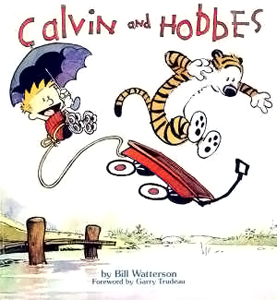
Calvin and Hobbes is a daily American comic strip created by cartoonist Bill Watterson that was syndicated from November 18, 1985, to December 31, 1995. Commonly described as "the last great newspaper comic", Calvin and Hobbes has enjoyed enduring popularity, influence, and academic and even a philosophical interest.
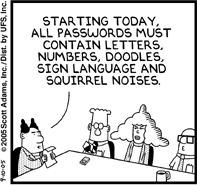
Dilbert is an American comic strip written and illustrated by Scott Adams, first published on April 16, 1989. It is known for its satirical office humor about a white-collar, micromanaged office with engineer Dilbert as the title character. It has led to dozens of books, an animated television series, a video game, and hundreds of themed merchandise items. Dilbert Future and The Joy of Work are among the best-selling books in the series. In 1997, Adams received the National Cartoonists Society Reuben Award and the Newspaper Comic Strip Award for his work. Dilbert appears online and as of 2013 was published daily in 2,000 newspapers in 65 countries and 25 languages.

Garfield is an American comic strip created by Jim Davis. Originally published locally as Jon in 1976, then in nationwide syndication from 1978, it chronicles the life of the title character Garfield the cat, Odie the dog, and their owner Jon Arbuckle. As of 2013, it was syndicated in roughly 2,580 newspapers and journals; the comic held the Guinness World Record for being the world's most widely syndicated comic strip.

Peanuts is a syndicated daily and Sunday American comic strip written and illustrated by Charles M. Schulz. The strip's original run extended from 1950 to 2000, continuing in reruns afterward. Peanuts is among the most popular and influential in the history of comic strips, with 17,897 strips published in all, making it "arguably the longest story ever told by one human being". At the time of Schulz's death in 2000, Peanuts ran in over 2,600 newspapers, with a readership of roughly 355 million across 75 countries, and had been translated into 21 languages. It helped to cement the four-panel gag strip as the standard in the United States, and together with its merchandise earned Schulz more than $1 billion. In 2015, a movie adaptation was released by Blue Sky Studios.

The Far Side is a single-panel comic created by Gary Larson and syndicated by Chronicle Features and then Universal Press Syndicate, which ran from December 31, 1979, to January 1, 1995. Its surrealistic humor is often based on uncomfortable social situations, improbable events, an anthropomorphic view of the world, logical fallacies, impending bizarre disasters, references to proverbs, or the search for meaning in life. Larson's frequent use of animals and nature in the comic is popularly attributed to his background in biology. The Far Side was ultimately carried by more than 1,900 daily newspapers, translated into 17 languages, and collected into calendars, greeting cards, and 23 compilation books, and reruns are still carried in many newspapers. After a 25-year hiatus, in July 2020, Larson began drawing new Far Side strips offered through the comic's official website.
FoxTrot is an American comic strip written and illustrated by Bill Amend. The strip launched on April 10, 1988, and it originally ran seven days a week. From December 31, 2006 onwards, FoxTrot has only appeared on Sundays.

King Features Syndicate, Inc. is an American content distribution and animation studio, consumer product licensing and print syndication company owned by Hearst Communications that distributes about 150 comic strips, newspaper columns, editorial cartoons, puzzles, and games to nearly 5,000 newspapers worldwide. King Features Syndicate also produces intellectual properties, develops new content and franchises, and licenses its classic characters and properties.
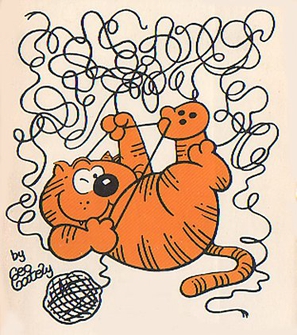
Heathcliff is an American comic strip created by George Gately in 1973, featuring the title character, an orange cat. Now written and drawn by Gately's nephew, Peter Gallagher, it is distributed to over 1,000 newspapers by Creators Syndicate, which took over the comic from McNaught Syndicate in 1988.

Beakman's World is an American educational children's television program. The program is based on the Universal Press Syndicate syndicated comic strip You Can with Beakman and Jax created by Jok Church. The series premiered on Wednesday, September 16, 1992, on TLC, and three days later on September 19, began a concurrent run in weekly syndication on 220 television stations across the United States through an agreement with Columbia Pictures Television Distribution.

Speech balloons are a graphic convention used most commonly in comic books, comics, and cartoons to allow words to be understood as representing a character's speech or thoughts. A formal distinction is often made between the balloon that indicates speech and the one that indicates thoughts; the balloon that conveys thoughts is often referred to as a thought bubble or conversation cloud.

Ask Shagg was a syndicated daily comic strip drawn by cartoonist Peter Guren from 1980 to 2020. It was distributed by Creators Syndicate; it had been distributed by United Feature Syndicate from 1980 until 1995. The strip has run in dozens of newspapers including The Boston Globe, The Columbus Dispatch, and the Seattle Post-Intelligencer. In each strip Guren, through his Shagg E. Dawg character, answered questions from readers about the animal kingdom. The strip retired on 5 January 2020.
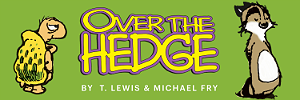
Over the Hedge is an American syndicated comic strip, written by Michael Fry, and drawn by T. Lewis. It tells the story of a raccoon, a turtle, a squirrel, and their friends, who come to terms with their woodlands being taken over, by suburbia, trying to survive the increasing flow of humanity and technology while becoming enticed by it at the same time. The strip debuted June 12, 1995.
Universal Press Syndicate (UPS), a subsidiary of Andrews McMeel Universal, was an independent press syndicate. It distributed lifestyle and opinion columns, comic strips and other content. Popular columns include Dear Abby, Ann Coulter, Roger Ebert and News of the Weird. Founded in 1970, it was merged in July 2009 with Uclick to form Universal Uclick.
Tiny Sepuku is a syndicated weekly comic strip created by Ken Cursoe based around a character named Tiny Sepuku who answers questions from his readers and generally dispenses love advice.
Downstown was an American syndicated comic strip created by Tim Downs that ran from 1974 to 1986.
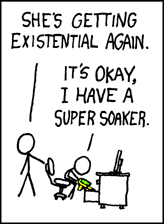
xkcd, sometimes styled XKCD, is a serial webcomic created in 2005 by American author Randall Munroe. The comic's tagline describes it as "a webcomic of romance, sarcasm, math, and language". Munroe states on the comic's website that the name of the comic is not an initialism but "just a word with no phonetic pronunciation".

Non-fiction comics, also known as graphic non-fiction, is non-fiction in the comics medium, embracing a variety of formats from comic strips to trade paperbacks.
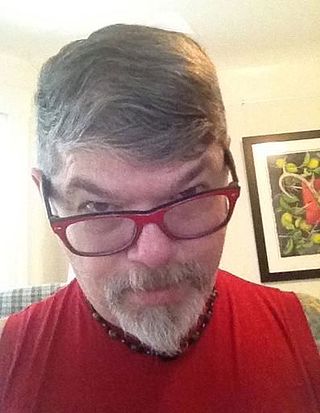
Jok Richard Church was an American cartoonist who created the Universal Press Syndicate syndicated comic strip You Can with Beakman and Jax, later adapted into the TV series Beakman's World. The series premiered September 18, 1992, on The Learning Channel (TLC) cable network and in national syndication. On September 18, 1993, it moved from national syndication to CBS Saturday morning children's lineup. At the peak of its popularity, it was seen in nearly 90 countries around the world.
Cartoonists Remember 9/11 is a series of comic strips run on the tenth anniversary of the September 11, 2001 attacks on the United States. It included cartoonists from King Features Syndicate, Creators Syndicate, Tribune Media Services, Universal Press Syndicate, and Washington Post Writers Group.
















